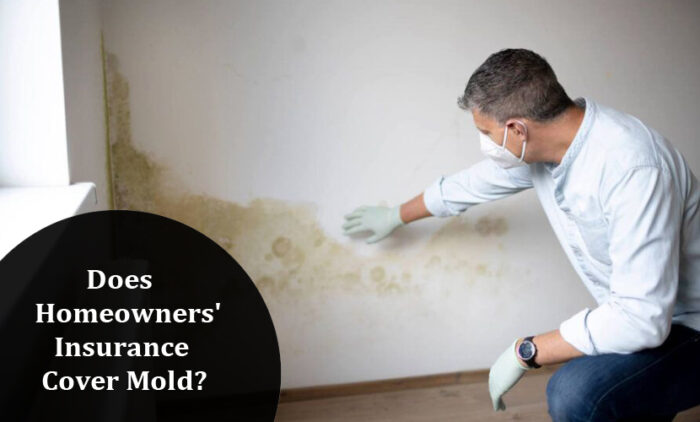Whether your homeowners’ insurance policy cover mold damage depends on whether you have a named perils or open peril policy.

Your insurer will specify the named perils covered or list the perils excluded from coverage. Standard policies typically cover perils like fire, lightning, hail, explosions, vandalism, theft, falling objects, and snow weight.
However, water-related damage and its secondary effects, such as mold, pose a more complex situation. When reviewing your policy documents, pay attention to the water and mold coverage details listed in the exclusion and condition sections.
If you choose extra mold coverage, you’ll get more details about it in the endorsement part.
What is Mold?
Mold, a type of fungus found in various indoor and outdoor environments, poses health risks, particularly certain molds like black mold that release chemicals, causing severe health issues.
Initially, insurers paid substantial sums for mold damage claims. However, they soon recognized the significant risk and began offering limited or no coverage for mold-related issues in many policies.”
When Does Mold Covered By Homeowners’ Insurance?
Generally, mold, mildew, fungus, or spores are covered by home insurance if they result from a specific problem covered by your policy. For example, if water damage from a burst pipe leads to mold growth, it’s likely covered.
To file a mold claim successfully, you need to demonstrate that the mold damage was sudden and accidental when discovered and reported to your insurer. This increases the likelihood of your insurance provider covering the damages.
However, mold coverage may be limited, often capped at $10,000. Some policies offer additional mold coverage with higher limits for an additional premium.
While many homeowners insurance policies exclude damage caused by mold, some exceptions provide limited coverage for mold contamination. Additionally, homeowners insurance doesn’t cover mold damage if it results from:
- Normal wear and tear
- Unaddressed long-term leaks
- Moisture or water from construction
- Poor repairs
Lastly, if you didn’t notice some water in your apartment and mold develops consistently and spreads to the walls and floorboards, your policy likely won’t cover it.
When Doesn’t Home Insurance Cover Mold?
Home insurance policies exclude coverage for mold due to negligence or lack of regular maintenance. This comprises mold damage from:
- Poorly sealed doors or windows.
- Unrepaired leaky faucets.
- Inadequate ventilation in moist areas like bathrooms.
Additionally, several other common causes of mold damage are typically not covered by standard home insurance policies such as:
Sump Pump Failure And Water Backup Damage
Damage from water backup or sump pump failure is often not covered by standard policies. However, many insurers offer optional coverage for sump pump failure and water backup as an additional option.
Flood Damage
Standard homeowner policies do not cover flood-related damage. For those at risk, purchasing separate flood insurance is advisable.
When it comes to flood insurance, coverage for mold damage may not be comprehensive. The extent of coverage for mold damage varies among flood insurance policies.
However, if you’re uncertain about what your policy includes, it’s advisable to consult with your insurer for clarification.
Additional Home Insurance Mold Coverage
There are two additional insurance options that you may consider adding to your homeowners’ insurance policy to potentially provide coverage for mold:
Water Backup Coverage
This coverage, also known as backup of sewers and drains or a sump pump, covers damage from drain backups, sewer line clogs, or sump pump failures.
If you have this coverage and discover mold after a water backup event, it should be covered. However, the coverage may be restricted to a specific dollar amount.
Hidden Water Damage Coverage
If leaks occur in areas hidden behind walls, cabinets, or beneath floors, they cause extensive damage over time, potentially causing mold growth.
With hidden water damage coverage on your home policy, mold removal expenses are regularly paid off.
How To File a Homeowners’ Insurance Claim For Mold
If you find yourself needing to file a homeowners insurance claim for mold, it’s important to act immediately to minimize the damage. Here’s how to proceed with filing a claim for mold with your home insurance company:
Report The Incident
Inform your insurance company about the mold issue, either online, in person, or over the phone. Your insurer will then assign an adjuster to your claim to initiate the process.
Document The Damage
Capture photographic or video evidence of the mold growth and any associated damage to your home and belongings.
Also, create a detailed list of all items affected by the mold to provide your insurance company with comprehensive information.
Remove Excess Water
Remove excess water and utilize a dehumidifier or air conditioner to help dry out the area. Also, place wet items outdoors in a secure location to facilitate drying.
If removing the water content is tough, consider hiring a professional. Your insurance agent may assist in locating reputable water removal contractors in your area.
Make Temporary Repairs
While major fixes should be avoided until after filing your claim, it’s important to undertake temporary repairs to prevent further damage to your home. For instance, if your apartment is occupied with excess water, you can remove wet carpeting.
Lastly, remember to keep all receipts for purchases associated with cleanup and temporary repairs, as these may be necessary when filing your insurance claim.
In the event of a water leak or burst pipe in your home, it’s important to stop the leak as quickly as possible. Here’s what you should do:
- Shut Off The Main Water Supply
Once you’ve located the main water shut-off valve, immediately turn it off to stop the flow of water. This action can help prevent further damage to your home and belongings.
Conclusion
Homeowners insurance usually doesn’t cover mold damage, as it’s considered preventable. Insurance providers often emphasize the importance of controlling humidity levels and ensuring proper ventilation in your home to prevent mold growth.
However, some insurers may offer mold coverage as an add-on. It’s important to check with your insurer to confirm whether mold coverage is included in your policy.



